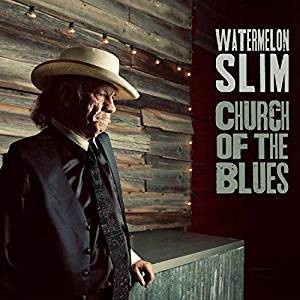Artist: Watermelon Slim
Album: Church of the Blues
Label: Northern Blues
Release Date: 1.25.2019

Watermelon Slim is back and he’s on the Northern Blues label where he garnered most of his 20 Blues Music Award nominations and his two wins. After two obscure releases, Bull Goose Rooster (2013) and Golden Boy (2017), Slim is sure to turn heads again with this, his 13th, Church of the Blues. Co-produced by Slim and Chris Hardwick, it’s a mix of seven new originals and seven tributes to past masters such as Muddy Waters and Mississippi Fred McDowell. And, he’s joined by some of his favorite blues people: Bob Margolin, John Nemeth, Nick Schnebelen, Albert Castiglia, Joe Louis Walker and Sherman Holmes.
Slim plays his trademark electric-slide resonator guitar and blows harmonica while joined by John Allouise on electric bass and Brian Wells on drums. There are several highlights, including the trading slides with Bob Margolin on Muddy’s “Gypsy Woman,” “Get Out of My Life Woman” where he sings alongside Sherman Holmes and John Nemeth, and the interesting “Mni Wiconi, The Water Song” where Joe Louis Walker takes lead guitar. He even returns to his protest roots with the bitterly expressive “Charlottesville (Blues For My Nation].”
Slim is known for his workingman songs and there’s no shortage of them here, singing his “Tax Man Blues,” pondering Heaven or Hell on “St. Peter’s Ledger,” or, in a clear highlight, stating his philosophy in the a cappella “Holler #4,” emblematic of so many solo approaches he developed while spending endless hours as a truck driver. He just rings with authenticity and passion. It’s not surprising that the renowned Jerry Wexler once said, “Watermelon Slim incarnates the deepest and truest roots of American music …one-of-a-kind pickin’ n’ singing Okie dynamo.” “Holler #4” is the true embodiment of that statement.
Since it’s been some time since we heard from Slim, it might help to briefly touch on his unique background. He was born William P. Homans III into a blueblood family in Boston but rejected that way of life early on. He was raised in North Carolina listening to the housekeeper sing John Lee Hooker songs. Slim attended Middlebury on a fencing scholarship but left early to enlist for Vietnam. While laid up in a hospital bed he taught himself upside-down left-handed slide guitar on a balsa wood model, listening to Mississippi Fred and using a Zippo lighter as the slide. Hence, his unique unorthodox sound, which he puts to use here, nodding to McDowell in “Highway 61.”
Slim first came to notice with the release of the only known protest record by a veteran during the Vietnam War. The project was Merry Airbrakes, a 1973 protest album with tracks Country Joe McDonald later covered. In the following 30-plus years Slim has been a truck driver, forklift operator, sawmiller (where he lost a partial finger), firewood salesman, collection agent, funeral officiator and at times a small-time criminal. Due to the last, Slim was forced to flee Boston and landed in his current home state of Oklahoma farming watermelons—hence his stage name. Somewhere in those decades since Vietnam Slim, completed two undergrad and a master’s degree, started a family, painted art and joined Mensa, the social networking group reserved for members with certified genius IQs.
When you watch Slim perform, especially as a one man band, you know every word is true. Thankfully, his storied legend continues with this terrific, heartfelt album.
—Jim Hynes







A few little corrections: I did go to Middlebury College in 1968, and in high school I was indeed an epeeist. In my career I won one AFLA Open tournament, finished second to 1956 Olympian Ralph Spinella in the 1968 Connecticut State Championship, and when Spinella decided not to go to the Nationals in June, I went, and finished 7th in 19-and-under epee, in which I faced at least one future Olympian. When I came back from Vietnam, I tried to re-establish my fencing at the New York Athletic Club, but looking back, I had to do too much life discovery to concentrate on the sport. I was fast, but not particularly graceful. I fenced in a few scattered tounaments thereafter, but never even made the repechage (the final round).
I was heavily involved with activist politics in the 1970s in the antiwar and antinuclear movements. In 1977 I was arrested at a sit-in at the Seabrook nuclear plant, and while incarcerated I met a man with whom I collaborated to stop the spraying of 2,4,5-T, the dioxin-containing ingredient in Agent Orange, on powerline right of ways (on people’s farms!), by the Power Authority of the State of New York. In that fight we won our greatest victory.
Although I did terminate my criminal associations in 1978, the fight against Agent Orange, and the realization that I was just spinning my wheels in Boston, were at least as important in my leaving that city, to which I eventually returned for another stay, a marriage, and the start of my trucking career, in household moving.
I now live in Clarksdale, Mississippi, for the last 9 1/2 years. However, I keep a toehold in Oklahoma, where I have more great friends and fans than anywhere else in the world.